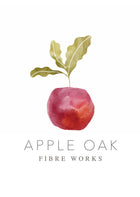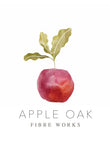Organic natural Indigo ~ Dye colour Blue
[our Indigo is NOT synthetic]
Country of Origin: India
The advantage in dyeing with Indigo is, that no mordant is needed. The water doesn't need to be heated to more than 40 degrees Celsius and a little goes a long way. We can dye 3-4 kg of Wool using 50g of Indigo.
There are many ways of dyeing with Indigo. Below you will find the recipe for a yeast vat. For a straight forward no-waiting-required approach, you can use Hydros as an oxygen remover. Waiting time approx. one hour.
Colourfastness: Excellent for dark colours, good for lighter colours
-------
Basic Recipe ~
It is possible to create a vat from indigo, lime (calcium hydroxide) and over-ripe fruit such as bananas or dates that relies on the chemistry of the sugars* rather than fermentation of the fruit. But it’s easier to simply use fructose shared in
Our Organic Sugar Vat Recipe
Or for a more lightfast solution go for the recipe below or for a quick Vat, use the Hydros Vat, but it does use a chemical oxygen remover.
Our Hydros Vat Recipe
Both recipe are also available as dye Kits
FERMENTATION USING YEAST:
For 500gr wool etc. at one time . (amount can be repeated several times using the same bath)
9l water
dye container with lid
separate pot for the water bath to add the container
110gr sugar
50gr dried yeast with out preservatives etc.
30gr bicarbonate of soda
40gr ground Indigo
thermometer
This Method requires the dye bath to be on a constant 40 degrees Celsius and shouldn't exceed 50 degrees Celsius. Ideally put the dye pot in a water bath on a wire rack to ensure even distribution of temperature.
-
Fill pot with 9l of water and heat to 40 degrees Celsius.
-
Mix sugar and yeast and add to the water. Leave until dissolved and bubbly.
-
Dissolve soda in a glass with hot water and add the dye, stir until smooth. Add to yeast mixture.
-
Close lid and ideally put into a bin bag, you want it as air locked as possible. Leave at steady temperature for 8 hours.
- Lift lid and stir carefully until all the foamed Indigo has returned into the dye. Try to stir as little air into it as possible.
- Close the pot up again and leave for 48 hours until the water is yellow green.
- The water will show a metallic shimmer on the surface when ready. Carefully stir it back in.
- Add the damp but not mordanted wool etc. make sure all are under the water add a plate or a metallic disc to press the wool etc. under the surface. Whatever swims at the top will be unevenly dyed.
-
Close it up and leave for 6 -12 hours.
-
Remove wool etc. and press out back into the dye bath.
-
Open wool etc. and leave exposed for at least 60min. All should turn blue.
- If you prefer a deeper blue add it to the dye bath again and repeat step 9.
-
Wash twice with a mild soap, then rinse 4-5 times using vinegar in the last bath.
- Hang up and air for a few days or weeks.
You can repeat this dyeing process using the same dye bath several times.













